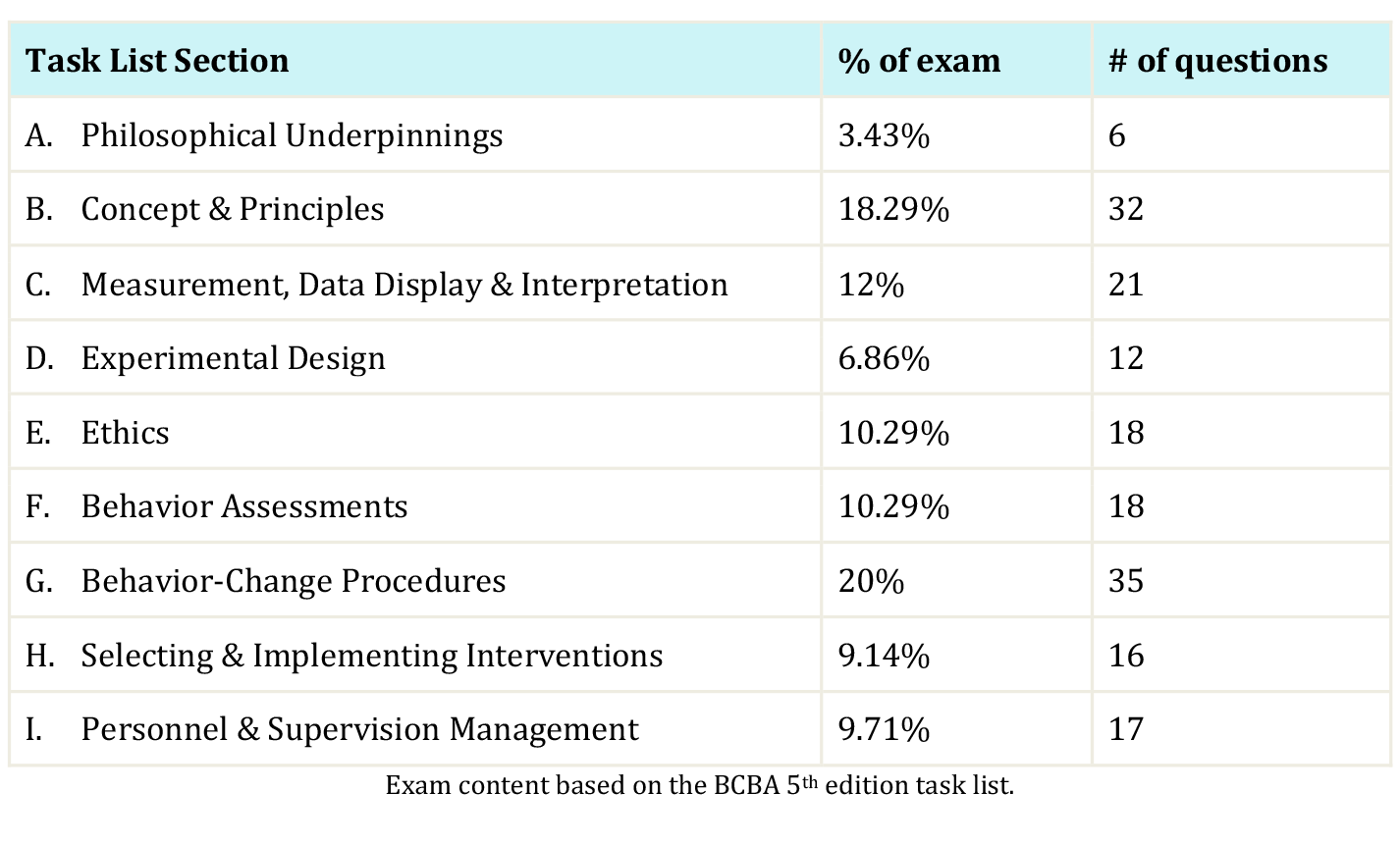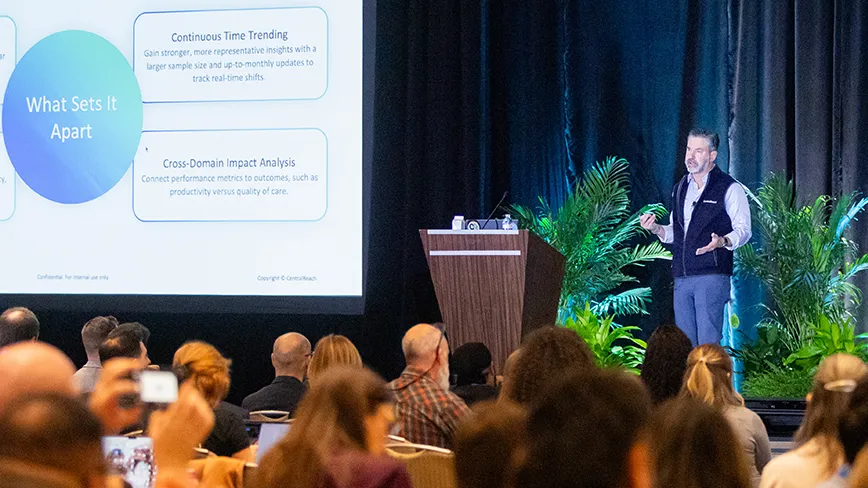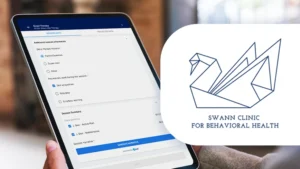As you finish up your degree and fieldwork hours, the final step is approaching. It’s almost time for your BCBA exam! At first glance, preparing for the BCBA exam can appear daunting. However, with the right preparation, you can take the steps needed to feel confident on exam day. Let’s review how to optimize your study preparation.
1. Review the BCBA handbook
The first thing to do, if you haven’t recently done so, is to review the BCBA handbook. There is a wealth of information in the handbook regarding the exam content, what to expect on exam day and more.
2. How do I know what’s on the exam?
The BCBA exam consists of questions directly related to the BCBA task list. The BCBA handbook outlines the number of questions on the exam from each task list section. As shown in the figure below, philosophical underpinnings are the section with the least weight. Only six exam questions are related to philosophical underpinnings. On the opposite end, there are 35 questions on behavior-change procedures making up 20% of the exam.

This information can be used to guide your study efforts. Suppose you feel confident in task list sections C through I. Your exam date is quickly approaching, but you are still struggling with sections A and B. In this case, it makes sense to focus more of your efforts on understanding section B, as the content from section B comprises a much larger portion of the exam.
3. Find your baseline measures
Before diving into your studies, take a full mock exam. Set aside a four-hour chunk of time and go through a mock as if it were the real thing. Completing a full mock exam will provide you with a number of baseline measures.
Baseline overall score.
Find your baseline score by diving the number of questions answered correctly by the total questions, then multiply by 100.Example: 120 questions answered correctly/175 total questions*100= 68%
Note: The BCBA exam consists of 185 total questions, but only 175 of the questions are scored. The exam does not indicate which 10 questions are not scored. Therefore, the suggested score calculation is not exactly how it will be scored on the actual exam.
Baseline fluency score
A key component of the exam is fluency in the content. You’ll want to not only answer the questions accurately but also relatively quickly. You can identify your fluency based on the number of questions you were able to answer within the four-hour time frame allotted.
Example: 145 questions completed in the 4-hour time frame. Knowing this, you’ll aim to gradually increase your speed.
Baseline score per task list section.
Identifying which areas of the task list are your strengths versus which areas need more work will help guide your study efforts tremendously.
Example: Section A: 6/6 | Section B: 12/32 | Section C: 18/21
Focus more time and energy on the sections in which the mock exam indicated you scored lower.
It is worth noting: Some mock exams (for example, those obtainable through CR Institute) don't require that you calculate your own score -- it can be done for you. Some provide section scores but also dive into the smaller category (task list items).
In addition to zeroing in on the content that you should study, mock exams can be a great way to determine what type of questions you struggle with. Most certification exams ask conceptual and application-type questions. Conceptual questions assess what you know, and application questions assess how well you apply that knowledge. CR Institute's mock exam lets you see how you performed on both question types within each task list area.
4. Create a schedule
While everyone studies differently, one thing is for sure: cramming your study preparation into the week or two before your BCBA exam is not the way to go. Planning out your study schedule far enough in advance is critical.
Each individual taking the exam will possess varying levels of knowledge and experience in the field, which means time spent studying will vary. However, a safe bet is to plan to devote one to six months to BCBA exam prep before sitting down for the test.
Once you identify how much time you will have to study before the exam, you should create a study plan. Outline the days and times you will study and block those times off on your calendar. These should be times when you can fully devote yourself to studying without distractions.
Your schedule can also include what sections of the task list you’ll focus on that day/week. Start by planning to study the areas of the task list where you scored the lowest on your mock exam.
5. Practice until fluent
There is a time limit of four hours for the BCBA exam. Finding a good pace is important. You’ll want to focus on both accuracy and fluency. Using digital SAFMEDS can increase your fluency in the concepts and principles. This is vital for exam day. When you are answering exam questions, you will be better able to dissect the question when you understand each of the concepts or acronyms used.
SAFMEDS is an acronym for Say All Fast Minute Every Day Shuffle. Using this method, digital SAFMEDS have already been created for the students and organized by Topic Areas or Terminology. The students are provided with the option to do Al a Carte, sequential, and group topics. Test yourself using the SAFMEDS method, dedicating at least 5-10 minutes to this daily.
Once you enter the SAFMEDS deck of your choosing, read the definition and say the term that definition describes. Click to indicate if you got it correct or incorrect so that the ABA Knowledge Builder Application can properly chart the data at the end of the timing.
- Say: Read the term and definition out loud, per the SAFMEDS method. This may take some getting used to, given that traditional flashcards are typically read silently.
- All: Study all the terms, including the ones you haven’t yet mastered. You won’t complete all terms in one practice round since they are only one minute, but each term should have an equal chance of being chosen.
- Fast: Answer as quickly as possible without erroring. Find that balance between speed and accuracy.
- Minute: Set a timer for one minute or adjust the time as needed. Answer as many as you can during this time.
- Every Day: Practice these daily. With each SAFMEDS session being one minute, you should be able to find a few times each day to practice the terms.
- Shuffle: The system will automatically randomize the SAFMEDS every time you start a new round.
Review the cards you answered incorrectly or did not answer quickly. Take data on the number of cards you answered correctly in each one-minute period.
6. Apply the concepts to the real world
BCBA exam prep does not have to be boring. Studying by applying behavior-analytic concepts to real-world situations not only makes studying more enjoyable. It also helps you generalize the concepts, making it more likely that you will understand different ways of applying them. This is needed for the exam, but more importantly, it will be needed in your future role as a behavior analyst.
There are many ways you can apply the concepts you are studying to the real world. Let’s review a few.
7. Graph your study progress
What better way to continue learning and applying behavioral concepts than to graph your own progress?
Here are several ways you can do so.
• SAFMEDS:
Graph the number of flashcards answered correctly in your first SAFMEDS round each day. Analyze your progress toward fluency in terminology.
• Mock exam scores:
Graph your scores for each mock exam you take. Monitor your progress in your overall scores, the number of questions answered in the 4-hour time frame, and/or your scores in each task list section.
• Daily/weekly study time:
Graph the time spent studying each day or week. Analyze this graph to find trends in your study efforts. Consider how that information could be used to self-monitor your own behavior.
8. Analyze, refine, and fine-tune your study habits
Use the principles of behavior to analyze and modify your own behavior as it relates to your study efforts.
- Measure and analyze your study behaviors; see above (TL C-3 through C-11)
- Run component, comparative, and parametric analyses on your study behaviors (D-6)
- Use self-management strategies (TL G-20)
- Apply reinforcement procedures to increase focused studying (TL G-1, G-14)
9. Client work
Your fieldwork experience doesn’t have to end once you hit 2,000 hours. If you are still working in the field with BCBA supervision, work with your BCBA to identify activities related to areas of focused study that you could do. For example, if you’re struggling with preference assessments (TL F-5), you could ask your BCBA if you can run these assessments with clients on your caseload.
10. Mock exams and practice questions
Continue completing mock exams and practice questions. BCBA Exam questions are written in a particular way, so getting comfortable with this format will go a long way. Continue using the results of mock exams to refocus your study efforts on the areas that need it the most.
Wrap-up!
The BCBA exam is the final piece to achieving board certification as a behavior analyst. You have come so far in completing all other requirements - don’t lose that momentum now! Preparing using the aforementioned suggestions and any other individualized strategies that work for you will have you well on your way toward accomplishing your goal of board certification.
Also check out our post on BCBA Test Prep with our Knowledge Builder.






